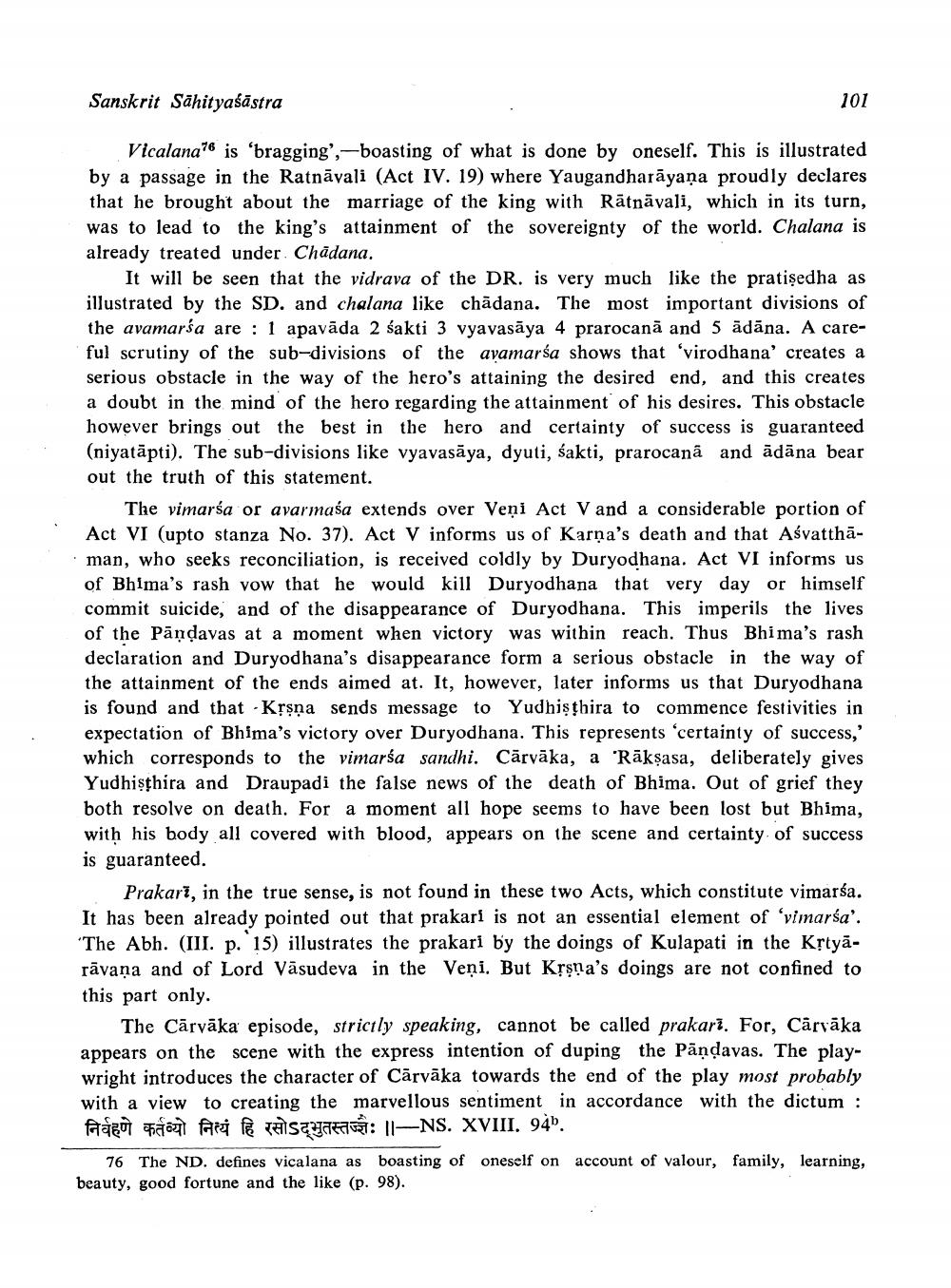________________
Sanskrit Sahityalästra
Vicalana is 'bragging',-boasting of what is done by oneself. This is illustrated by a passage in the Ratnavali (Act IV. 19) where Yaugandharāyaṇa proudly declares that he brought about the marriage of the king with Rätnävall, which in its turn, was to lead to the king's attainment of the sovereignty of the world. Chalana is already treated under Chadana.
101
It will be seen that the vidrava of the DR. is very much like the pratiṣedha as illustrated by the SD. and chalana like chadana. The most important divisions of the avamaria are: I apavada 2 sakti 3 vyavasaya 4 prarocanã and 5 ādāna. A careful scrutiny of the sub-divisions of the avamarsa shows that 'virodhana' creates a serious obstacle in the way of the hero's attaining the desired end, and this creates a doubt in the mind of the hero regarding the attainment of his desires. This obstacle however brings out the best in the hero and certainty of success is guaranteed (niyatäpti). The sub-divisions like vyavasaya, dyuti, śakti, prarocanã and ādāna bear out the truth of this statement.
The vimarsa or avarmasa extends over Veņi Act V and a considerable portion of Act VI (upto stanza No. 37). Act V informs us of Karna's death and that Asvatthäman, who seeks reconciliation, is received coldly by Duryodhana. Act VI informs us of Bhima's rash vow that he would kill Duryodhana that very day or himself commit suicide, and of the disappearance of Duryodhana. This imperils the lives of the Pandavas at a moment when victory was within reach. Thus Bhima's rash declaration and Duryodhana's disappearance form a serious obstacle in the way of the attainment of the ends aimed at. It, however, later informs us that Duryodhana is found and that Krsna sends message to Yudhisthira to commence festivities in expectation of Bhima's victory over Duryodhana. This represents 'certainty of success," which corresponds to the vimarka sandhi. Cārvāka, a Räkṣasa, deliberately gives Yudhisthira and Draupadi the false news of the death of Bhima. Out of grief they both resolve on death. For a moment all hope seems to have been lost but Bhima, with his body all covered with blood, appears on the scene and certainty of success is guaranteed.
Prakart, in the true sense, is not found in these two Acts, which constitute vimarsa. It has been already pointed out that prakar! is not an essential element of 'vimarsa". The Abh. (III. p. 15) illustrates the prakari by the doings of Kulapati in the Kṛtyarāvana and of Lord Vasudeva in the Veni. But Krsna's doings are not confined to this part only.
The Carvaka episode, strictly speaking, cannot be called prakar1. For, Cārvāka appears on the scene with the express intention of duping the Pandavas. The playwright introduces the character of Cārvāka towards the end of the play most probably with a view to creating the marvellous sentiment in accordance with the dictum : निर्वहणे कर्तव्यो निश्वं हि रसोऽद्भुतस्तज्ज्ञैः ॥ —NS XVIII. 945.
76 The ND. defines vicalana as boasting of oneself on account of valour, family, learning, beauty, good fortune and the like (p. 98).




